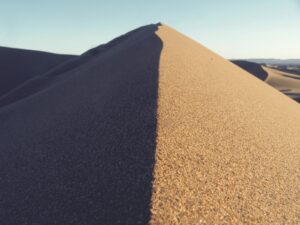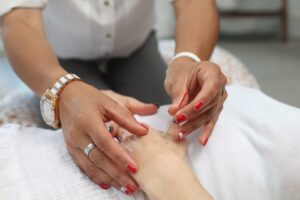Subscribe to the Newsletter
If you are interested in understanding how Traditional Chinese Medicine can improve your life sign up to my newsletter for the latest updates.

Lung point 9 has a number of important properties:
This page is all technical stuff, mainly useful to acupuncture students, and also to the author, to remind him of stuff he’s forgotten. If you’re interested in learning more about acupuncture and the ideas behind it, click here for something more appropriate.
In the wrist crease on the anterior forearm between the radial bone and the first metacarpal bone, between the radial artery and the tendon of abductor pollicis longus – the tendon that abducts the thumb.
Insert needles into Lung Point 9 perpendicular to the skin. Depth? – 0.25 cun is usually enough but in some people can be up to 0.5 cun.
When needling this point, some acupuncturists find the radial pulse, then press laterally to it with a fingernail to push it away (ie medially) as the needle penetrates. I’ve never needed to do this, however, because it’s quite hard to penetrate the artery wall, and the point is usually easy to find just medial to the abductor pollicis longus.
Lung point 9 produces a heavy aching sensation deep within the wrist joint, spreading out from the tip of the needle.
Because of the various actions of this point, the origin of the Lung channel in the epigastrium and stomach, the relationship between the lung and the heart in the Upper Jiao, and its relationship with the Large Intestine channel and zang, we can divide its actions into various groups.
However, please realise that in many cases the nature of the symptom means that it could be classified in several ways. Also, it would be wonderful to be able to ascribe complete healing of all the following symptoms to Lung point 9 alone, but in practice few acupuncturists would risk it: they’d use other points to back it up, depending on the exact diagnosis.
Duplication below is on purpose, and not intended to be complete.
Haematemesis: vomiting blood

When Lung qi is healthy, the movement of Blood around the body is harmonious. This means that when Lung qi is deficient or excessive, Blood movement becomes disturbed.
When deficient, it can seem impossible to feel the pulse at the wrist, and difficult even at other points eg the carotid artery in the neck.
An old trick if you can’t feel the pulse, is to needle Lung point 9: this brings qi to all the pulses, at least temporarily. In so doing, of course, you may alter the quality of the pulses making your diagnosis of the kind of pulse less certain:
| Lung-1 | Zhongfu | Middle Mansion |
| Lung-2 | Yunmen | Cloud Gate |
| Lung-3 | Tianfu | Heavenly Palace |
| Lung-4 | Xiabai | Protecting White |
| Lung-5 | Chize | Foot Marsh |
| Lung-6 | Kongxui | Great Opening |
| Lung-7 | Lique | Broken Sequence |
| Lung-8 | Jingqu | Channel Gutter |
| Lung-9 | Taiyuan | Great Abyss |
| Lung-10 | Yujo | Fish Region |
| Lung-11 | Shaoshang | Lesser Shang |
Click to return from Lung point 9 to Acupuncture Point location.

Stay in Touch!
No spam, only notifications about new articles and updates.

Book a Video consultation if you want to know more about your symptoms

This Introductory Chinese medicine course introduces you to the amazing thinking behind this ancient medicine, now increasingly in demand.

The Scottish College for Chinese medicine provides introductory courses for all, explaining Chinese medicine and its cultural background.

Master Tung’s acupuncture is a hidden treasure, lost to China but recovered in Taiwan from where it spread round the world.

Knee pain has five main causes. It’s certainly worth trying acupuncture before you resort to surgery!
Subscribe to the Newsletter
If you are interested in understanding how Traditional Chinese Medicine can improve your life sign up to my newsletter for the latest updates.
Subscribe to the Newsletter
If you are interested in understanding how Traditional Chinese Medicine can improve your life sign up to my newsletter for the latest updates.